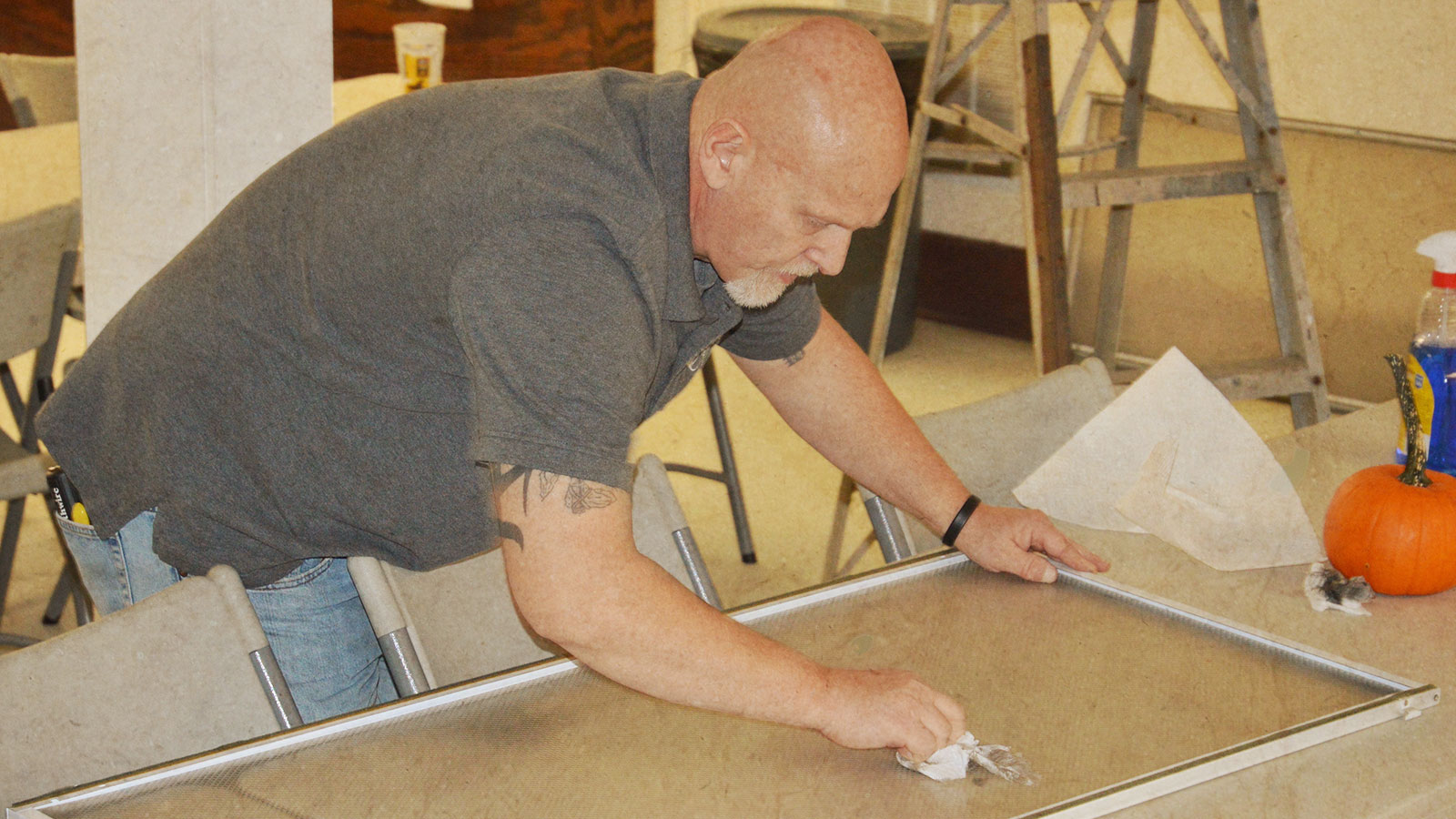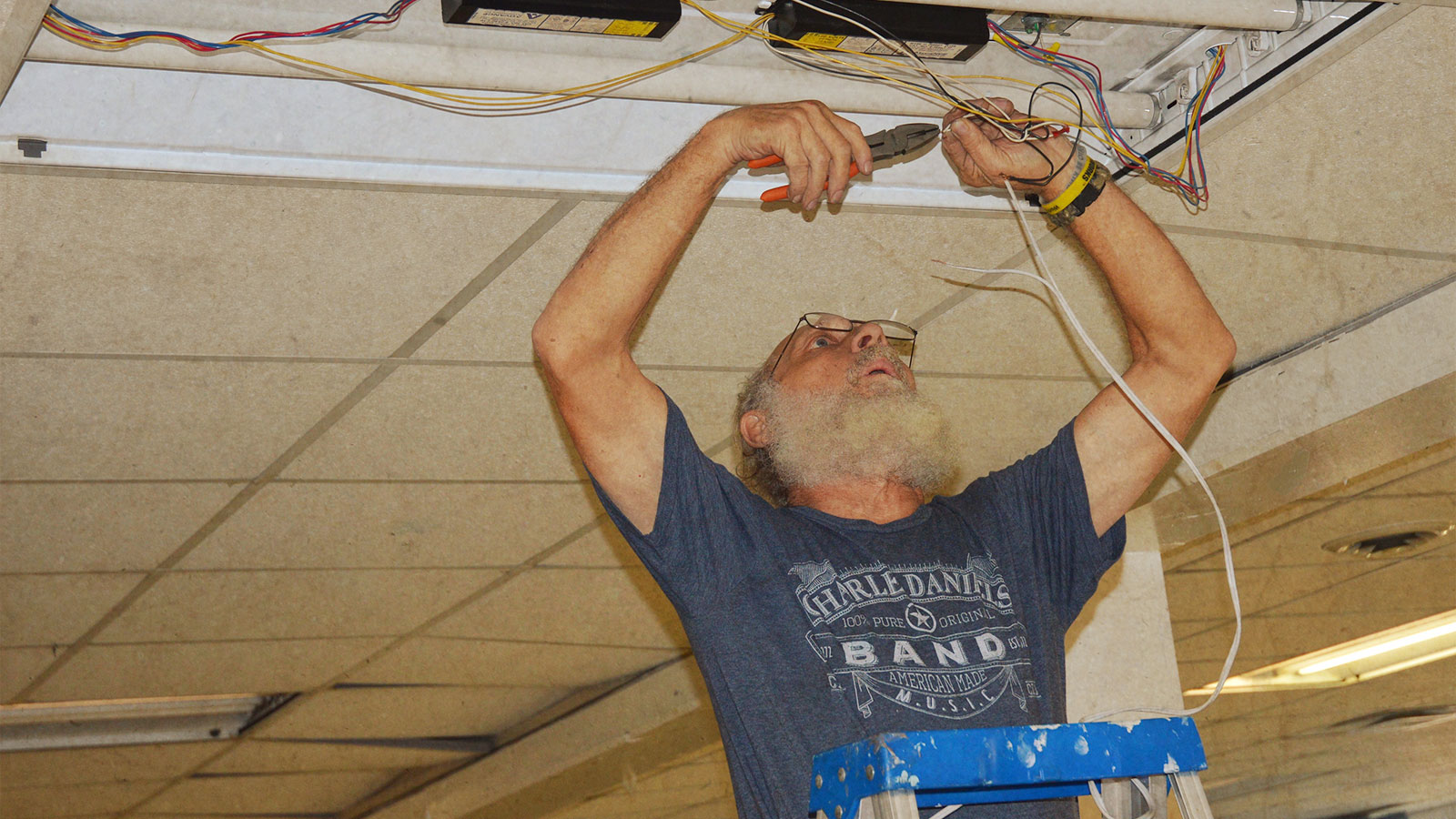Scott Shoupe didn’t want to follow his classmates into the coal mines when he graduated from Harlan High School in 1993. His ticket out — “to make something of myself” — was a baseball scholarship 130 miles north at Morehead State University.
But when his favorite sport started feeling more like a job than fun, the headstrong outfielder dropped out two years short of a bachelor’s degree. Shoupe returned home to Harlan County, an isolated and impoverished patch of southeast Kentucky, and like his father before him, signed up to mine coal.
“That’s all there was,” Shoupe said. “It was the one thing I could do to make money.”
King Coal has dominated this part of Appalachia for more than a century, powering local economies and offering lucrative, if dangerous, steady employment. That era is vanishing as mines shutter and coal companies across the country file for bankruptcy. So Shoupe is following his father, Carl, once again. But this time, it’s into a career that’s less about unearthing energy and more about using it super-efficiently.
At 43, he’s about to become the third graduate of a “new energy internship” for the region’s displaced coal workers. It’s a project of the Mountain Association for Community Economic Development, a local nonprofit. Enrollees in the program earn full-time wages and health benefits for six months while immersing themselves in the intricacies of lighting, weatherization, solar panels, and decoding utility bills.
Despite President Trump’s campaign mantra about championing miners and “putting our great coal miners back to work,” the industry continues to shed jobs. And that means people like Shoupe need a hand to move from an old, carbon-heavy economy to a new, green one.
Coal once defined southeast Kentucky’s character. Starting in the 1930s, miners in Harlan County went on strike against their employers, demanding fair wages and safer working conditions. Their efforts led to pitched battles with employers over the decades, sometimes turning the area into a “war zone,” with bombings and shootouts.
All those union mines have shut down, along with plenty of others. Nearly 6,600 Kentuckians worked in coal at last count, down roughly 80 percent in three decades, according to statistics from the federal Mine Safety and Health Administration. Some 41 percent of people in Harlan County live in poverty, according to the Census Bureau, more than triple the national average. And surrounding counties aren’t much better off.
Mechanization has played a role in the region’s struggles. Enormous machines now do the same work that miners once did by hand. But the main reason is that the country is weaning itself off the dirty fossil fuel. Hydraulic fracturing has created a glut of cheap natural gas, and technological advances have made solar and wind competitive. The result: a growing bounty of green jobs and fewer and fewer people heading from high school to the mines in Appalachia.

Scott Shoupe. Photo by Elizabeth McGowan
According to a recent report from E2, a national nonprofit pushing policies that benefit both the economy and the environment, roughly 25,000 Kentuckians are employed in all aspects of energy efficiency. That’s more than three times as many who work in coal.
So it makes sense that the Mountain Association for Community Economic Development, or MACED, is working to shift Kentucky’s workers from a dying sector to a growing one. Even though traditional coal states have been slow to embrace a clean-energy economy, making the sort of home improvements that pay for themselves through lower utility bills isn’t a tough sell. The fact that it also helps beat a path to a new future is sometimes besides the point.
“This isn’t sexy like granite countertops or a new bathroom,” said Chris Woolery, who oversees the internship program at MACED. “It’s about making homes more affordable, healthier, and comfortable.”
The organization got the internship program up and running in 2017 after cobbling together several million dollars from a variety of sources, including a state employment program funded with federal money. A big boost came the Appalachian Regional Commission, a federal agency tasked with supporting economic growth in the 13 Appalachian states.
Kentucky’s surplus of displaced coal workers means MACED can be selective with internship assignments. After Woolery and his colleagues winnow applications to a choice few, they interview candidates over Skype and give them exercises on spreadsheets, hoping to find people who can be equally adept at installing solar panel on rooftops and serving as ambassadors for energy efficiency and clean energy. Woolery expects to have 12 interns graduate by the end of the year.
To Woolery, the internships align with MACED’s focus on redeveloping the region’s economy. Beyond that, it’s part of a wider mission, a shift toward mining the region’s ingenuity instead of its natural resources. “We’re trying to think more broadly than just a program,” he said. “Our idea is to create a clean-energy ecosystem in the state.”
Wendy Wasserman, a spokesperson for the Appalachian Regional Commission, said it’s no simple task to reinvent the economy of a region that has been dependent on one industry for so long. The difficulty is compounded by an opioid epidemic that has pummeled Appalachia especially hard. “There is this expectation that these economies long dominated by coal would turn on a dime,” Wasserman said. “That’s a false expectation because this isn’t an immediate switch.”
After all his talk about reviving miners’ livelihoods, Trump delivered a gut-punch to the region by eviscerating the commission’s budget during his first year in office. Congress has since reversed course, and the agency’s budget of $165 million this year is among the biggest in its 53-year history.
Since 2015, the agency has awarded $145 million through its POWER Initiative to a wide array of revitalization projects across 312 Appalachian counties. Each project requires matching funds from a partner, such as a college, local government, or a nonprofit like MACED.
“This isn’t a one-and-done where we hand out money and walk away,” Wasserman said about the initiative. “This requires long-term thinking.”
On a crisp fall day, Shoupe and his classmate, John Craft, returned to the Hemphill Community Center at a former coal camp in Letcher County, which neighbors Harlan County to the northeast. Built in 1944, the two-story brick building was drafty, and the electric bill was squeezing the center’s budget.
Two weeks earlier, Shoupe and Craft, 61, had conducted a blower door test on the former schoolhouse to pinpoint the source of its air leaks. Guided by Woolery, they extracted two ancient, bulky air conditioner window units, sealed windows, and adjusted an HVAC vent so energy wouldn’t be wasted heating a storage room.
With the help of Josh Bills, another MACED efficiency specialist, Shoupe and Craft — both certified as electricians during their mining days — set about replacing 30 fluorescent lighting fixtures with LEDs in the first floor kitchen and main activity room.
“I’m continually bowled over that they would put themselves out for us,” said Gwen Johnson, the community center’s volunteer secretary-treasurer.
Johnson, her mother, and two daughters were all once students at the school, which closed in 1990. The building sat dormant for eight years before the tiny community reinvented the space. By 2010, Johnson had convinced the center’s board to apply for a grant to replace the mammoth, faltering coal furnace with four heat pumps. Recently installed wifi programmable thermostats have also helped curb costs.
Still, the income from hosting reunions, proms, wedding receptions, martial arts classes, meals for seniors, as well as the sale of bread, desserts, and pizza cooked in a new brick oven hasn’t been enough to cover the bills. So Johnson turned to MACED to ask about installing solar panels on the building’s roof.
After weeks studying the building’s electric use, Bills suggested energy-saving measures as a more practical first step, as the community center would likely need to take out loans to install rooftop solar. He also knew a retrofitting project would be perfect hands-on training for his interns.
Johnson was thrilled by the idea. She expects the project will eventually save her threadbare budget thousands of dollars on lighting alone.
“Our electric bill, which can be as high as $1,600 a month, is the biggest drain on our finances,” she said. “That’s just crazy when you’re trying to keep a low-cost space open.”

John Craft. Photo by Elizabeth McGowan
On average, rural households across the country spend 40 percent more than their city-dwelling counterparts on energy bills, according to a recent study by the American Council for an Energy-Efficient Economy. And that so-called energy burden is especially high in Kentucky and surrounding states, where rural residents spend an outsize portion of their income on home energy bills.
“These towns in eastern Kentucky are filled with people who want to stay here,” Woolery said. “This kind of program makes it a tiny bit easier.”
Frank Morris grew up in a family of coal miners in Perry County, just northwest of Letcher County. Just like his grandfather and uncles, the mines lured him in 2005 when he was just out of high school.
Over the next decade, Morris was laid off twice — first as a coal truck mechanic and then as a coal truck driver. After each layoff he found jobs in security, retail, and as a handyman. In 2015, he stayed home with his newborn son, William, but soon found himself itching to get back to work outside the house.
“I come from a family where you have to work,” Morris said. “That’s our mindset.”
He signed up for MACED’s program in September 2017, interning at the Housing Development Alliance, a nonprofit based in Hazard, an old coal city of about 5,000 that’s also the Perry County seat. Morris was the first to graduate from MACED’s program last spring and took a job as an energy auditor at the alliance.
One arm of the nonprofit helps low-income residents in Perry and three surrounding counties pay for energy-saving renovations with loans and grants. Much of the housing stock in the region is old and compromised.
“What I do is like writing a prescription for a house,” Morris said. “I could use big, fancy terms when I explain energy efficiency, but it’s better if I refer to it all as an investment. I can show people how much it will cost and how long it will take to pay it back.
“I never sell them something they don’t need, because if they see me at the Walmart they’re going to go after me.”
Morris, now 32, says people spread the word to neighbors when they see the benefits of his work. He relishes retelling the story of an elderly woman who told him that her house was always way too cold or too hot. She was suspicious of his claims that a new heat pump, insulation, and air sealants could save her at least $20 a month. But she agreed to let him make the changes anyway.
When Morris returned with the last bit of paperwork, she hugged him tightly, tickled that the temperature of her house was “just right” for the first time.
Morris said he regularly rejects offers to return to the coalfields. The pay was good, but he doesn’t want to spend the better part of the day away from home, leaving him little time to play with his now 3-year-old son. His work at the Housing Development Alliance is much more flexible. “The way they let us balance our home and work life is something I’ve never had,” he said. “I would have missed his childhood if I’d stayed with coal and those 12- to 16-hour days.”
Morris is convinced that coal companies won’t be around much longer, and that something has to replace them. “If we don’t develop other industries in this region, the area is going to be a ghost town,” he said. “Coal just isn’t the future.”
It was a similar story with Shoupe. He rose to be an assistant mine superintendent, a top management job, while hopping between mines in Kentucky, West Virginia, and Alabama. Some years he took home more than $100,000. But the job was consuming his life, ruining his health, and depriving him of time with his young daughter.
Shoupe felt stuck, so he quit last year and moved back to his Harlan County hometown of Benham to be near his father and work temporarily as a handyman.
Benham is the former coal camp where the elder Shoupe, Carl, has been instrumental in not only introducing an energy efficiency initiative to homeowners, but also reducing the city’s utility bills by coordinating the addition of solar panels to the Kentucky Coal Mining Museum’s roof. The three-story brick building on Benham’s main street once served as the coal camp commissary.
Unfortunately, Scott Shoupe said, many people expect displaced coal miners to settle for fast food or other minimum-wage jobs. He and Craft are hoping to offer them an alternative. The pair envisions starting a business together focusing on energy-saving retrofits for businesses after completing their training on April 1.
“With what I learn here, I want to put people to work with good pay and good benefits,” Shoupe said. “I want to see this area prosper, something we haven’t seen in a long time.”



